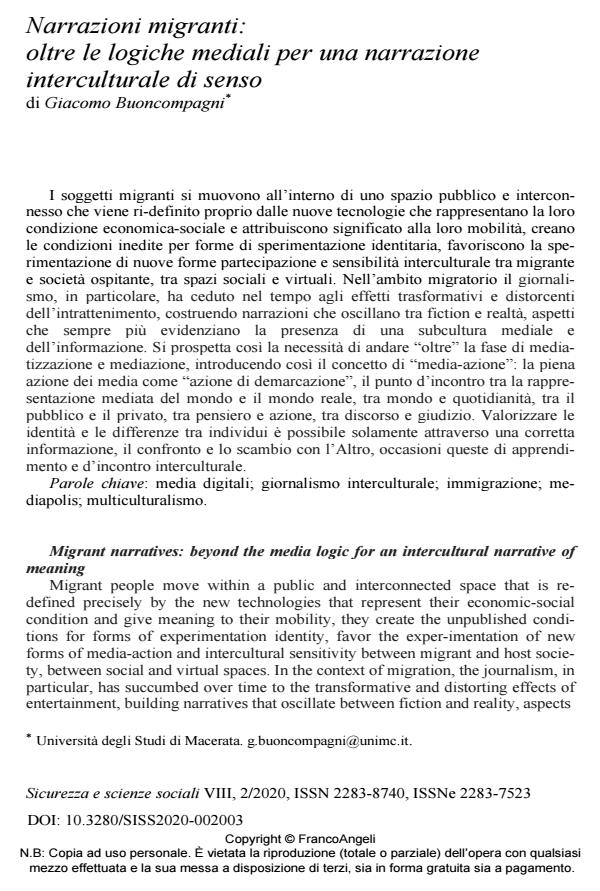Migrant narratives: beyond the media logic for an intercultural narrative of meaning
Journal title SICUREZZA E SCIENZE SOCIALI
Author/s Giacomo Buoncompagni
Publishing Year 2020 Issue 2020/2 Language Italian
Pages 10 P. 23-32 File size 201 KB
DOI 10.3280/SISS2020-002003
DOI is like a bar code for intellectual property: to have more infomation
click here
Below, you can see the article first page
If you want to buy this article in PDF format, you can do it, following the instructions to buy download credits

FrancoAngeli is member of Publishers International Linking Association, Inc (PILA), a not-for-profit association which run the CrossRef service enabling links to and from online scholarly content.
Migrant people move within a public and interconnected space that is redefined precisely by the new technologies that represent their economic-social condition and give meaning to their mobility, they create the unpublished condi-tions for forms of experimentation identity, favor the exper-imentation of new forms of media-action and intercultural sensitivity between migrant and host soci-ety, between social and virtual spaces. In the context of migration, the journalism, in particular, has succumbed over time to the transformative and distorting effects of entertainment, building narratives that oscillate between fiction and reality, aspects Università degli Studi di Macerata. g.buoncompagni@unimc.it. that increasingly highlight the presence of a media and information subculture. Thus the need to go "beyond" the mediation and mediation phase is thus pro-posed, thus introducing the concept of media-action: the full action of the media as "demarcation action", the meeting point between the mediated representation of the world and the real world, between world and everyday life, between the public and the private, between thought and action, between speech and judgment. Valuing identities and differences between individuals is only possible through cor-rect information, comparison and exchange with the Other, opportunities for learning and intercultural encounters.
Keywords: Digital media; intercultural journalism; immigration; mediapolis; multiculturalism.
- Altheide D.L., Snow R.P. (1979). Media Logic. Beverly Hills: Sage Publications.
- Altheide D.L., Snow R.P. (1991). Media worlds in the postjournalism era. New York: Routledge.
- Binotto B., Bruno B., Lai V. (2016). Tracciare confini. L’immigrazione nei media italiani. Milano: Franco Angeli.
- Corte M. (2016). Giornalismo interculturale e comunicazione nell’era digitale. Padova: CEDAM.
- Dal Lago A. (1999). Non persone. L’esclusione dei migranti in una società globale. Milano: Feltrinelli.
- Elliot P. (1972). The making of a television series, London: Constable.
- Fishman M. (1977). Manufacturing the news: The social organization of media news production. PhD. Dissertation. Santa Barbara: University of California.
- Garcea E. (1996). La comunicazione interculturale. Roma: Armando.
- Husband C. (2000). Media and the Public Sphere in Multietnics Societies. In: Cottle S. Ethnic Minorities and the Media. Buckingham: Open University Press.
- Innis H. (1982). Le tendenze della comunicazione. SugarCo edizioni: Milano.
- Katz E., Lazarsfeld P. (1995). Personal Influence. The Part Played by People in Mass Communication. NY: Free Press.
- Marini R. (2017). Media logic. La logica dei media. Roma: Armando editore.
- McLuhan M. (1994). Gli strumenti del comunicare. Milano: il Saggiatore.
- Musarò P., Parmiggiani P. (2014). Media e migrazioni: etica, estetica e politica della narrazione umanitari. Milano: FrancoAngeli.
- Portera A. (1999). Educazione umanistica interculturale nella famiglia. In: Secco L. Portera A. L’educazione umanistica interculturale nelle agenzie educative. Padova: Cedam: 11-30.
- Sibhatu R. (2004). Il cittadino che non c’è. L’immigrazione nei media italiani. Roma: Edup.
- Silverstone R. (2002). Perché studiare i media?. Bologna: il Mulino.
- Silverstone R. (2009). Mediapolis. La responsabilità dei media nella civiltà globale. Milano: Vita&Pensiero.
- Stevenson N. (1999). The Transformation of the Media: Globalisation, Morality and Ethics. London: Longman.
- Sibathu R. (2004). Il cittadino che non c’è. L’immigrazione nei media italiani. Roma: Edup.
- Steiner G. (1984). Dopo Babele. Firenze: Sansoni.
Giacomo Buoncompagni, Narrazioni migranti: oltre le logiche mediali per una narrazione interculturale di senso in "SICUREZZA E SCIENZE SOCIALI" 2/2020, pp 23-32, DOI: 10.3280/SISS2020-002003